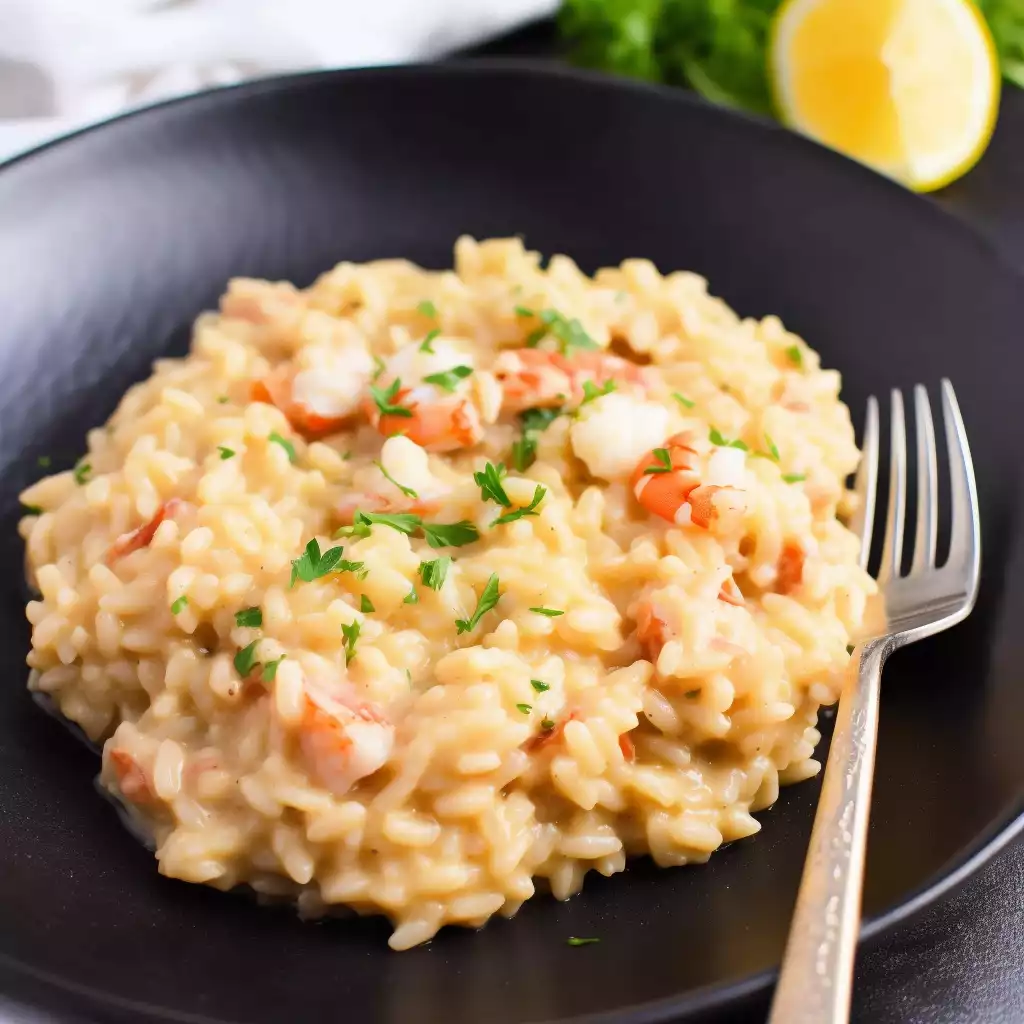
Lobster risotto, a dish synonymous with elegance and gourmet dining, has a fascinating history deeply rooted in the rich culinary traditions of Italy. This recipe, which blends the creamy texture of Arborio rice with the luxurious taste of lobster, offers a unique experience to your taste buds.
The origin of risotto traces back to Northern Italy, where the slow-cooking method of rice with broth, derived from Asian influences, was embraced.
The addition of lobster, however, is a more modern twist, representing the fusion of Italian tradition with a flair for opulence. Lobster, once considered food for the less fortunate, has risen in status over the centuries, becoming a symbol of fine dining and luxury.
Making lobster risotto isn’t particularly difficult, but it does require attention and patience. The key to its success lies in the gradual addition of stock to the rice, ensuring a creamy, al dente finish. It’s a dish that asks for care rather than culinary prowess, making it accessible to home cooks at all skill levels.
There are numerous variations of this dish. Some prefer to add a touch of white wine for depth, while others might include different herbs or cheeses for a unique flavour profile. The use of saffron, as suggested in our recipe, is optional but adds a lovely hue and subtle complexity to the dish.
This lobster risotto recipe is more than just a meal; it’s a culinary journey through Italian history and a testament to how simple ingredients, when combined thoughtfully, can create a dish of extraordinary elegance and flavour.
Each spoonful promises a blend of creamy rice, enriched with the sweetness of lobster, creating a symphony of flavours that is sure to impress.
Remember, the beauty of this dish lies not just in its luxurious ingredients but also in the love and patience with which it is prepared. Whether you’re cooking for a special occasion or looking to treat yourself, this lobster risotto is a recipe that promises a memorable dining experience.
Expert Tips: Constantly stir the risotto as you add the stock. This helps release the rice’s starch, resulting in that signature creamy texture.
Preparing lobster risotto is like crafting a masterpiece, where every ingredient plays a vital role. Let’s explore the significance of each component and possible alternatives to adapt this luxurious dish to your taste or pantry availability.
Arborio Rice: The backbone of any risotto, Arborio rice is famed for its ability to absorb liquids and flavours, yielding a creamy texture without becoming mushy. Its starch content is key to the dish’s creaminess. If Arborio isn’t available, Carnaroli or Vialone Nano rice are excellent substitutes, both retaining a similar creamy yet firm texture.
Lobster Tails: Lobster adds a touch of luxury and a succulent, sweet flavour that elevates the dish. While lobster is irreplaceable in terms of flavour and texture, for a more budget-friendly or readily available option, you could use prawns or shrimp. They won’t replicate the exact lobster taste but will still complement the creamy rice beautifully.
Onion: Onion acts as a flavour enhancer, subtly contributing to the overall taste without overpowering the other ingredients. Shallots can be used as an alternative, offering a milder, slightly sweeter taste.
Garlic: Garlic adds depth and a slight pungency, enriching the risotto’s flavour profile. If you’re not a fan of garlic, you can reduce the amount or omit it, though it does add a necessary flavour layer.
Fish or Vegetable Stock: The stock gradually infused into the rice brings out the dish’s richness and depth. Chicken stock can be an alternative, although it will slightly change the flavour profile. The key is to use a high-quality stock, as it significantly influences the dish’s taste.
Parmesan Cheese: Parmesan lends a salty, nutty flavour that complements the lobster’s sweetness. If Parmesan isn’t to your taste or you’re seeking a different texture, try Pecorino Romano or Grana Padano for similar umami qualities.
Olive Oil & Butter: These fats are crucial for sautéing and imparting richness. While olive oil and butter are a classic combination, you can use all butter for a richer taste or all olive oil for a lighter version.
Saffron Threads (Optional): Saffron, though optional, adds a unique aroma and colour. There’s no direct substitute for saffron’s distinct flavour, but for a different aromatic touch, a pinch of turmeric could add colour, albeit with a different taste profile.
Salt and Black Pepper: These seasonings are essential for enhancing and balancing all the flavours. Always adjust to your taste preference.
Fresh Parsley: Parsley adds a fresh, herby note that contrasts the rich, creamy risotto. If parsley isn’t your favourite, try chives or a little bit of thyme for a different herbaceous note.
Understanding the role of each ingredient in lobster risotto allows you to appreciate the harmony of flavours and textures in the dish. It also provides the flexibility to tweak the recipe to your liking or according to what you have on hand.
Remember, cooking is not just about following a recipe; it’s about creating something that delights your taste buds and brings joy to your table.
Expert Tips: Don’t overcook the lobster. Lobster meat can become tough and chewy if overcooked. Add it towards the end of the risotto cooking process, just long enough for it to become tender and cooked through.
While risotto is best enjoyed fresh, you can prepare it ahead of time with a few adjustments. Cook the rice until it’s just underdone, then cool and store it. When you’re ready to serve, reheat the risotto slowly, adding a bit more stock to bring back the creamy texture. Add the lobster at the last minute to avoid overcooking.
Absolutely! For a vegetarian version, you can replace the lobster with hearty vegetables like mushrooms or butternut squash. These ingredients offer a wonderful texture and flavour that beautifully complements the creamy risotto.
Risotto is ready when the rice grains are creamy on the outside yet still slightly firm (‘al dente’) in the middle. The overall consistency should be somewhat loose, not too thick. It should flow slightly when served, not stand stiffly on the plate.
Yes, frozen lobster tails work well in this recipe. Just ensure they’re thoroughly defrosted and patted dry before cooking. Frozen lobster can be a more accessible and budget-friendly option while still providing great flavour.
Yes, you can use chicken stock as an alternative. It will change the flavour profile slightly but still provides a rich base for the risotto.
Remember, cooking is an art, and your personal touches make each dish uniquely yours. Don’t hesitate to experiment and adjust the recipe to suit your taste and preferences!
Expert Tips: Use high-quality ingredients, especially the stock and Parmesan. The flavour of your risotto heavily relies on these components, so choosing good quality stock and freshly grated Parmesan can make a significant difference.
Here are some more recipes for you to enjoy! If you my recipes don’t forget to rate and leave a comment.
If you have any recipe suggestions, please do not hesitate to ask me. A great way to stay in contact with me is through Instagram, Facebook, Twitter and YouTube. Don’t forget to tag me @CookwithNabeela in your recipe photos!

Subscribe now to receive my latest recipes directly in your inbox. Stay up-to-date and never miss out!

I love to cook! I want to share with you my favourite, delicious family-friendly recipes. I want to inspire you to create fantastic food for your family every day.
Add your first comment to this post